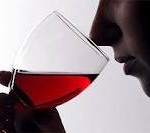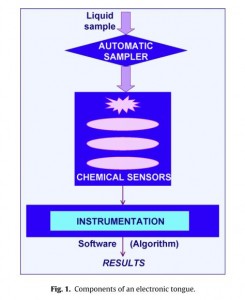
Using E-Tongues for the Analysis of Wine Quality: Examples of Applications
| December 27, 2011

Source: http://blogs.guardian.co.uk/food/wine_tasting440.jpg
Within recent years, there has been a push to develop new technology for the analysis of food (including wine) that is simple, yet low-cost, fast, accurate, and easy to use. Having this sort of technology allows the rapid analysis of foods/beverages, in an attempt to quickly determine the quality without large sample waste. E-tongues (electronic tongues) have been frequently studied within the past several years, and have shown great promise to analyzing the quality and chemical characteristics of wine and other foods.
What is an E-tongue?
The strict definition of an e-tongue is “a multisensory system for liquid analysis based on chemical sensory arrays and a suitable pattern recognition method”. In other words, an e-tongue is able to analyze liquid samples by recognizing chemical compounds within the sample, and performing data analysis based on the chemical profile of the sample. In a way, an e-tongue performs similarly to human taste, however is much more sensitive with sensory threshold capabilities much lower than most humans. Studies have even found that results from the analysis of wines by e-tongues were correlated to sensory descriptors provided by an expert panel of humans.
Figure 1, which comes from a 2010 Analytica Chimica Acta article by Escudar-Gilabert and Peris, provides an informative general schematic of the components of an e-tongue. Generally, e-tongues are made up of four different components: 1) an automatic sampler; 2) an array of chemical sensors of varying selectivity; 3) instrumentation to obtain the signal; and 4) software to process and analyze the signal. There are a variety of sensors used today in food quality analysis, including potentiometric sensors, voltammetric sensors, optical sensors, impedimetric e-tongues, amperometric sensors, and mass sensors, all of which have advantages and disadvantages.
Applications of the E-tongue in the Analysis of Wine
To date, there have been many applications of the e-tongue technology in the analysis of wine (too much to describe in detail in just one blog post!). Examples of applications studied so far include: i) monitoring of the aging process; ii) discriminating between oak type and toasting levels; iii) analysis of different treatments on phenolic composition; iv) predictions of chemical parameters; v) examining authenticity via chemical parameters; vi) discriminating between different grape varieties, origins and vintage; vii) discriminating between reds and whites; viii) correlation of sensory characteristics and chemical parameters; and ix) discriminating between different aging methods and the predicting the age of the wine.
Authenticity Applications
Determining the authenticity of wine is very important, particularly when involving high sums of money often exchanged for a rare bottle of wine found at an auction. Historically, wine fraud is a big business, and using an e-tongue is just one of many technologies/methods used to determine whether a wine is authentic or counterfeit. Specifically, e-tongues have been successfully implemented in authenticity analysis of wine by identifying features such as grape variety and geographic origin, as well as detecting chemical additives to wine that are sometimes used to enhance the sensory properties of the fraudulent wine.
Other studies have used an array of voltammetric sensors in e-tongue analysis of wine to determine authenticity of wines. Using different families of sensor materials (phthalocyanines, and conducting polypyrrole polymers), studies have been successfully able to detect chemical additives in fraudulent wine, with strong correlations between the analysis and chemical and sensor parameters from more traditional analysis methods. By using different families of sensor materials, scientists have been able to enhance the cross-selectivity of the assay, as well as the ability to discriminate between different wines.
Discrimination of Oak Barrel versus Oak Chip Aging
A more recent application of the e-tongue in the analysis of wine relates to the aging process of wine. As a result of the relatively high cost of oak barrels, winemakers have been searching for a comparable alternative at a fraction of the cost, which is often the use of oak chips in stainless steel tanks (a practice we know good and well on this blog). A 2010 study in Electrochimica Acta by Gay et al used an e-tongue in the analysis of red wines aged in oak barrels versus red wines treated with oak chips/staves, and compared the results with analysis from traditional chemical methods, and human sensory panel results.
The results from this study showed that the use of oak chips/staves in conjunction with a micro-oxygenation system can be detected using e-tongue analysis not only during the first stages of aging, but also in the final product. The e-tongue was sensitive enough to be able to detect the chemical differences between wines aged in oak barrels and wine treated with oak chips/staves, since the phenolic composition of the two types of wine are different. Interestingly, the e-tongue was also able to detect the geographic origin of the wood itself, since different types of oak wood have different chemical profiles. Not only was the e-tongue able to detect specific polyphenols/anthocyanins, but these results were also well correlated with traditional chemical analysis as well as human sensory analysis.
These results, in addition to results from other past studies, indicate that e-tongue analysis is a strong analytical tool for predicting the polyphenol content of wine, and can be a good complementary method to traditional methods in detecting the use of alternative aging methods of wine.
Other E-sensory Methods: E-noses and E-eyes
E-tongues are not the only new technologies for analyzing wine (and other foods). Other technologies have been created, which like an e-tongue can analyze and discriminate different types of wine, including electronic noses and electronic eyes. The electronic eye is designed to analyze the color of wine, while the electronic nose is designed to analyze the odor of a wine (focusing on the volatiles above the liquid). By combining all three technologies (e-nose, e-eye, and e-tongue), studies have shown an increase in the amount of information extracted from a wine sample, thus potentially giving more accurate chemical analysis and more accurate identification of the wine of study.
For example, one study used the three technologies separately and then together to analyze the volatile and chemical parameters of wines stored with different bottle closure types. Focusing on volatile permeability of the closures, the e-nose and e-eye, which are more sensitive to volatile compounds, were better able to discriminate between the wines stored with different closures than the e-tongue, which is more sensitive to the organoleptic properties of the wine related to oxygenation and polyphenol content. When combining all three technologies, the study found significant improvements in discrimination capabilities (i.e. ability to distinguish between wines), which can be a valuable method for estimating the characteristics and chemical parameters of wine in complement with traditional sensory analysis performed in wineries.
Conclusions
From the monitoring of the aging process, to discriminating between different varieties and origins, to determining the authenticity of potentially fraudulent wines, using e-tongue sensor analysis (in conjunction with other technologies like e-noses and e-eyes) is a promising technology that can be used in the wine industry. The successful analysis of these technologies shows great promise to the process of analyzing the quality of wines, which could overall reduce the time required for such an analysis and also the amount of financial overhead required to perform them.
About The Author
Rebecca Yeamans
Becca Yeamans is the owner/writer of the science-based wine blog, The Academic Wino, as well as the Tasting Room Manager at a vineyard in central Virginia. With a Bachelor of Science in Biology and a Master of Science in Environmental Science, her solid background in science and research allows her to approach wine blogging with a unique style that is both informative to those in the industry, and entertaining for those simply wishing to learn.


